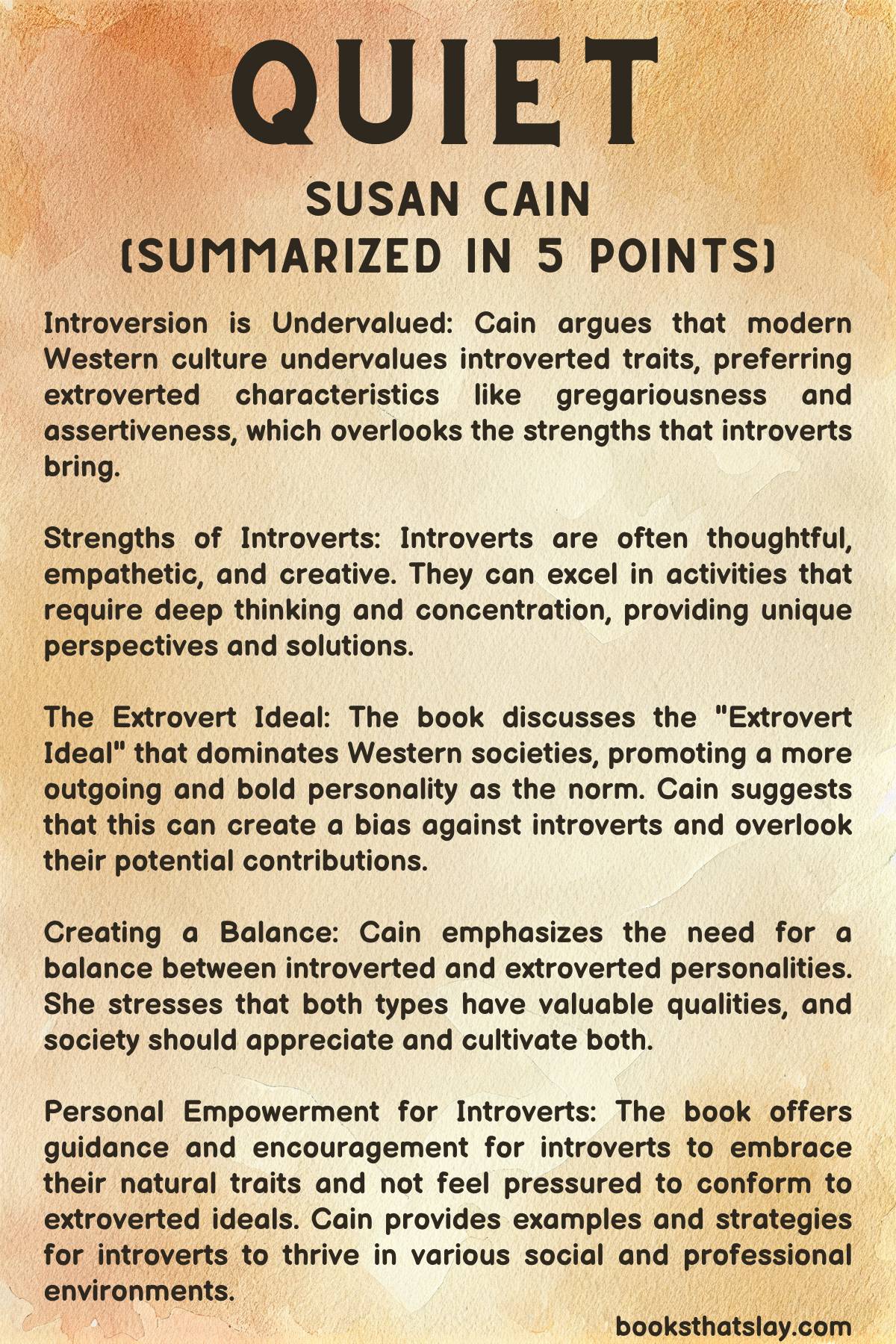Quiet: The Power of Introverts | Summary and Key Lessons
“Quiet: The Power of Introverts in a World That Can’t Stop Talking” is a non-fiction book by Susan Cain that was published in 2012. The book dives deep into the subject of introversion, offering an alternative view to a society that often seems dominated by extroversion.
Quiet The Power of Introverts Summary
The book begins by examining the rise of the “Extrovert Ideal” in the West, which is the preference for gregarious, assertive, and often domineering personalities.
It delves into how society places a high value on charismatic individuals who are sociable, outgoing, and comfortable in the spotlight, while often undervaluing and misunderstanding those who are reflective, quiet, and prefer solitude or one-on-one interactions.
Cain goes on to detail what she calls the “myths” of introversion, dispelling common misunderstandings about introverts. This includes the incorrect assumption that introversion is the same as being shy or antisocial.
Instead, she explains that introversion and extroversion are more about how people respond to stimulation: introverts feel most alive and capable when they’re in quieter, more low-key environments, while extroverts thrive in busy, high-stimulation situations.
Through rigorous research and compelling anecdotes, Cain explores the advantages and disadvantages of both introverted and extroverted traits.
She examines how these traits influence our relationships, work, school life, and even leadership abilities. In particular, she cites studies indicating that introverts are often overlooked as leaders despite their capacity for careful planning and thoughtful decision-making.
The book also considers how cultural expectations and norms can impact introverts, focusing on how East Asian cultures, for instance, tend to value introverted characteristics more than Western societies.
It discusses the importance of understanding and respecting introversion in children, who may need different styles of parenting and teaching to thrive.
In retrospect, Cain suggests ways for introverts to harness their strengths and navigate a world that tends to favor extroverts. She advises introverts on how to work within their nature, rather than against it, and encourages them to find their preferred levels of stimulation, manage their energy, and embrace their unique gifts.
Finally, the book calls on society to recognize and value the power of introverts. Cain argues that in doing so, we could maximize the talents of all people, creating a more balanced, thoughtful, and creative society.

Also Read: Zero to One | Summary + Key Lessons
Key Lessons
1. The Power and Value of Introversion
A key lesson from the book is that introversion is not a personality flaw or a deficit, but a strength with its own unique power. Cain meticulously highlights the value of introversion, celebrating characteristics like sensitivity, thoughtfulness, and the capacity for deep concentration.
By citing historical and contemporary figures like Rosa Parks, Albert Einstein, and Bill Gates, she demonstrates how introverts have made invaluable contributions to society.
For instance, Einstein’s introspective nature helped him ponder complex theoretical problems leading to breakthroughs in physics. This lesson encourages society to appreciate and make room for introverts and teaches introverts to embrace their unique traits and abilities.
2. The Necessity of Solitude for Creativity and Problem Solving
Cain emphasizes the importance of solitude for creativity and problem-solving in a world that leans towards teamwork.
Drawing from psychological studies and real-world examples, she highlights how uninterrupted, solitary focus often fosters more innovative ideas and solutions than group brainstorming sessions.
One instance she cites is Steve Wozniak’s development of the first Apple computer.
It was during periods of intense solitary work that Wozniak made significant technological advancements, thereby exemplifying how solitude can spur creativity.
This lesson serves as a reminder that while collaboration is essential, we must also create spaces for individuals to think and work independently, recognizing that breakthroughs often come from deep, solitary focus.
Also Read: The Omnivore’s Dilemma | Summary and Key Ideas
3. Understanding and Embracing Different Communication Styles
The book elucidates that introverts and extroverts communicate differently, each with their unique advantages.
Extroverts often excel in verbal communication and can command a room in group settings, while introverts might prefer written communication or one-on-one conversations where they can express their thoughts more thoroughly and thoughtfully.
For instance, Cain describes how some introverted leaders effectively run organizations by listening more than they speak and asking insightful questions.
This understanding fosters more effective communication in relationships, workplaces, and broader society.
By recognizing these differences and adjusting our expectations accordingly, we can encourage fruitful interactions and collaboration, thereby fostering inclusivity and understanding in diverse settings.
4. Embracing the Power of ‘Soft Power’
Often, the stereotypical leader is known to be extroverted, charismatic, and assertive.
However, Cain presents an alternative leadership style exhibited by introverts, one that uses influence rather than command, listening over speaking, and deep understanding as opposed to surface-level engagement.
Through examples like Mahatma Gandhi and Eleanor Roosevelt, she highlights how introverted leaders have used their calm, thoughtful, and empathetic natures to inspire others, evoke change and lead effectively without fitting the stereotypical mold of leadership.
Gandhi’s nonviolent resistance, for instance, was a prime example of leveraging soft power to lead a revolution. This lesson illuminates the significance of diverse leadership styles and the profound impact that introverted leaders can make.
Final Thoughts
In summary, “Quiet” is a deep and enlightening exploration of introversion in a predominantly extroverted world. It combines research, personal stories, and practical advice to challenge societal biases and champion the unique strengths and contributions of introverts.
Also Read: